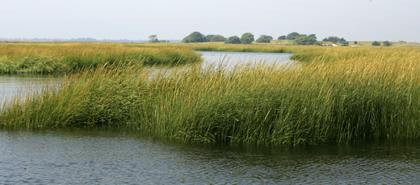By Ivan Pereira
The city’s Department of Environmental Protection gave its first major update last week on its plans to save the deteriorating saltwater marshland in Jamaica Bay.
The agency published its one−year progress report on the state of the 3,000−acre ecosystem Oct. 1 as part of its Jamaica Bay Watershed Protection Plan. Although it has made some progress in addressing the environmental problems with new plans and pilot programs, the DEP is reworking some of its proposals, according to DEP Commissioner Emily Lloyd.
“Jamaica Bay is one of the largest coastal wetland ecosystems in New York state,” she wrote in the report’s opening letter. “[T]here is tremendous value in preserving the integrity of its marsh islands and perimeter wetland areas for flood and storm surge protection of area residents.”
Last October, the Jamaica Watershed Protection Plan Advisory Committee, which was created in 2005 by the City Council, issued the results of a study that showed Jamaica Bay had lost nearly 70 percent of its marshland over the last half century and if nothing was done, all the marshes would be gone by 2012.
The report, which took 2 1⁄2 years of research by various government and private groups, indicated that excess nitrogen from storm water, largely fed into the bay through four DEP water filtration plants in Queens and Brooklyn, was a strong factor in the marsh loss.
In the last year, Lloyd said the city has undertaken some measures to decrease the excess nitrogen. In May, the DEP completed the first phase of a storm sewer upgrade in southeast Queens to reduce the amount of rainwater that ends up in the bay.
The agency has also been distributing rain barrels to nearby residents and is constructing a new detention tank that will soon be “on−line to limit the overflows of combined sewers into” Jamaica Bay, according to Lloyd.
With the assistance of state and federal grants, the DEP was able to install three boat pump−out facilities within the bay for the large number of boaters who travel within the ecosystem and must dispose of sewage.
As for its own facilities, which some environmental groups contend are the main contributor to the deterioration, the DEP’s plans to upgrade its water filtration plants with nitrogen filters are still in limbo as it is still working with the state Department of Environmental Conservation on how the new technology will be implemented.
The DEP, however, has secured funding of nearly $2 million for pilot projects slated for “early 2009” that will introduce oysters, bacteria, mussels and phytoplankton as a way to naturally combat the excess nitrogen.
Dan Mundy, a lifelong Broad Channel resident and member of the committee, said he was still going through the specifics of the update as of press time, but urged DEP to get a move on with its plans.
“It is a good sign because they are working on things, but when are they going to implement it?” he asked.
Lloyd said DEP has scheduled two scientific symposiums on the subject that will take place Oct. 28 at the U.S. Customs House in Manhattan and Oct. 29 at Kingsborough Community College.
Reach reporter Ivan Pereira by e−mail at ipereira@timesledger.com or by phone at 718−229−0300, Ext. 146.

































